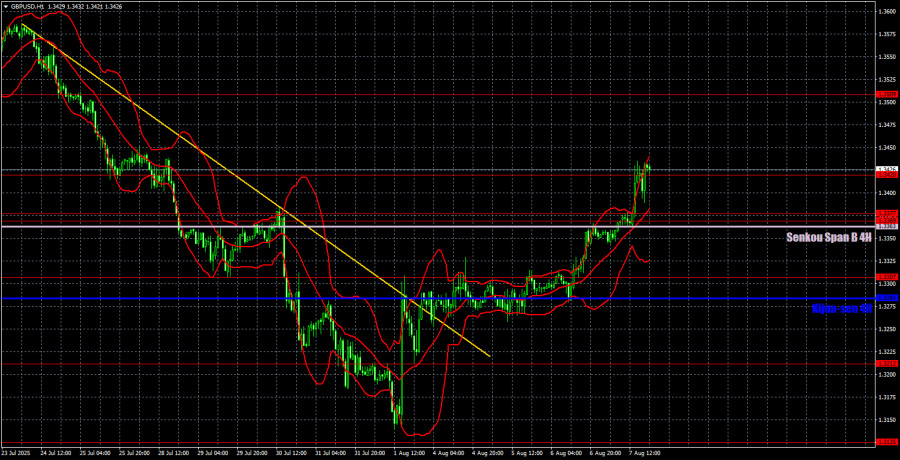On Thursday, the GBP/USD currency pair continued its upward movement. The Bank of England ultimately decided to cut its key interest rate, yet the British pound strengthened — something that may seem illogical at first glance. However, as we noted yesterday, the BoE's meeting does not significantly alter the outlook for either the dollar or the pound. This year, the BoE has cut rates twice, while the Federal Reserve has not done so even once. And yet, for 80% of the time, the dollar has been falling, and the pound rising. Thus, monetary policy still has only a limited effect on currency movements.
The trade war remains the dominant factor, and Donald Trump raised several tariffs again this week. So, with one hand, Trump signs trade agreements, while with the other he issues orders to impose new tariffs — and it's the latter that is working overtime. The escalation of the trade conflict continues to gain momentum, and the U.S. dollar has already sufficiently corrected ahead of a new decline. To start with, the British pound may take advantage of the dollar's weakness to return to 1.38, and then aim for the psychological level of 1.40.
The 5-minute time frame clearly shows how erratic Thursday's price movements were. This is not surprising, as the BoE's meeting results triggered volatility in the market. Traders were acting emotionally, which caused sharp swings in both directions. Before the meeting results were released, no trade signals were formed, and after the release, it made little sense to act on any that followed.

COT reports for the British pound show that in recent years, the sentiment of commercial traders has been constantly changing. The red and blue lines, which represent the net positions of commercial and non-commercial traders, frequently cross and are mainly near the zero mark. They've nearly converged again, indicating an approximately equal number of long and short positions.
The dollar continues to decline due to Trump's policies, so, in principle, the market makers' demand for the pound sterling is currently not particularly significant. The trade war will continue in some form for quite a while. Demand for the dollar will continue to decline. According to the latest report on the British pound, the "Non-commercial" group closed 5,900 BUY contracts and opened 6,600 SELL contracts. Thus, the net position of non-commercial traders fell by 12,500 contracts over the reporting week.
In 2025, the pound rose significantly, but it's important to understand that there was one main reason: Trump's policies. Once that factor is neutralized, the dollar could begin to rise again, but no one knows when that will happen. It doesn't matter how fast the net position for the pound rises or falls. The dollar is falling regardless—and typically at a faster rate.

On the hourly time frame, the GBP/USD pair has broken through the trendline, and on the daily chart, it bounced off the important and strong Senkou Span B line. As a result, the short-term trend has shifted to bullish. From our point of view, the fundamental backdrop remains unfavorable for the U.S. dollar, so we expect the continuation of the "2025 trend" over the long term. Trump continues to take actions that push the dollar downward.
For August 8, we highlight the following important levels: 1.3125, 1.3212, 1.3369–1.3377, 1.3420, 1.3509, 1.3615, 1.3681, 1.3763, 1.3833, 1.3886. The Senkou Span B line (1.3363) and Kijun-sen (1.3284) can also serve as signal levels. It's recommended to set the Stop Loss at breakeven once the price moves 20 pips in the right direction. Ichimoku indicator lines may shift throughout the day and should be considered when identifying trade signals.
No significant events are scheduled for Friday in either the UK or the U.S., so volatility may be reduced during the day. However, keep in mind that the overall fundamental backdrop remains sharply negative for the dollar. Therefore, if we see another decline in the U.S. currency tomorrow, it would not be surprising.
We believe that on Friday, the British pound may very well continue its rise. The nearest level from which to consider opening long positions is 1.3420. If strong sell signals appear, short positions may also be relevant, but we wouldn't count on a significant decline in the pair at this point.